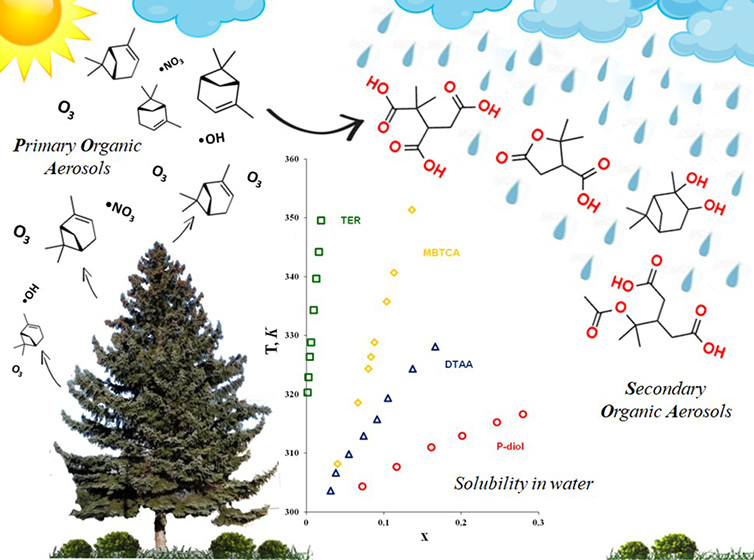Physicochemical Properties of Terebic Acid, MBTCA, Diaterpenylic Acid Acetate, and Pinanediol as Relevant α-Pinene Oxidation Products
Kołodziejczyk, A., Pyrcz, P., Błaziak, K., Pobudkowska, A., Sarang, K., Szmigielski, R.
ACS Omega (2020)
Abstract
 The physicochemical properties and the synthesis of four α-pinene oxidation products, terebic acid, 3-methyl-1,2,3-butanetricarboxylic acid (MBTCA), diaterpenylic acid acetate (DTAA), and pinanediol, are presented in this study. The physicochemical properties encompass thermal properties, solubility in water, and dissociation constant (pKa) for the investigated compounds. It was found that terebic acid exhibits a relatively high melting temperature of 449.29 K, whereas pinanediol revealed a low melting temperature of 329.26 K. The solubility in water was determined with the dynamic method and the experimental results were correlated using three different mathematical models: Wilson, NRTL, and UNIQUAC equations. The results of the correlation indicate that the Wilson equation appears to work the best for terebic acid and pinanediol. The calculated standard deviation was for 3.79 for terebic acid and 1.25 for pinanediol. In contrast, UNIQUAC was the best mathematical model for DTAA and MBTCA. The calculated standard deviation was 0.57 for DTAA and 2.21 for MBTCA. The measured water solubility increased in the following order: pinanediol > DTAA ≥ MBTCA > terebic acid, which affects their multiphase aging chemistry in the atmosphere. Moreover, acidity constants (pKa) at 298, 303, and 308 K were determined for DTAA with the Bates–Schwarzenbach spectrophotometric method. The pKa values obtained at 298, 303, and 308 K were found to be 3.76, 3.85, and 3.88, respectively.
The physicochemical properties and the synthesis of four α-pinene oxidation products, terebic acid, 3-methyl-1,2,3-butanetricarboxylic acid (MBTCA), diaterpenylic acid acetate (DTAA), and pinanediol, are presented in this study. The physicochemical properties encompass thermal properties, solubility in water, and dissociation constant (pKa) for the investigated compounds. It was found that terebic acid exhibits a relatively high melting temperature of 449.29 K, whereas pinanediol revealed a low melting temperature of 329.26 K. The solubility in water was determined with the dynamic method and the experimental results were correlated using three different mathematical models: Wilson, NRTL, and UNIQUAC equations. The results of the correlation indicate that the Wilson equation appears to work the best for terebic acid and pinanediol. The calculated standard deviation was for 3.79 for terebic acid and 1.25 for pinanediol. In contrast, UNIQUAC was the best mathematical model for DTAA and MBTCA. The calculated standard deviation was 0.57 for DTAA and 2.21 for MBTCA. The measured water solubility increased in the following order: pinanediol > DTAA ≥ MBTCA > terebic acid, which affects their multiphase aging chemistry in the atmosphere. Moreover, acidity constants (pKa) at 298, 303, and 308 K were determined for DTAA with the Bates–Schwarzenbach spectrophotometric method. The pKa values obtained at 298, 303, and 308 K were found to be 3.76, 3.85, and 3.88, respectively.



